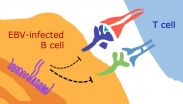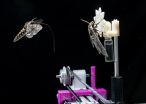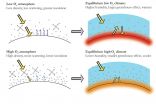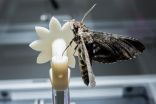(Press-News.org) About 90% of adults worldwide are infected with Epstein-Barr virus, or EBV. The virus infects B cells (the white blood cells that make antibodies) and can contribute to B-cell-derived cancers, but in most people it remains dormant--a state scientists refer to as "latent infection"--for the rest of their lives. A study published on June 11th in PLOS Pathogens sheds new light on why the infected person's immune system cannot eliminate EBV, or the associated cancer risk.
Interested in the immune response against EBV, Andreas Moosmann, from the Helmholtz-Zentrum in Munich, Germany, and colleagues focused in this study on the role of a viral protein called LMP2A, which is present in latently infected B cells and also in many EBV-associated cancers, which have somehow escaped detection and elimination by the immune system. The scientists studied an engineered EBV virus that cannot make LMP2A and compared this mutant virus with the normal one.
They infected human B cells with normal and LMP2A-deficient EBV. Because EBV transforms these cells, meaning that they can be changed to grow indefinitely, the researchers were able to examine so-called lymphoblastic cell lines that contained either virus. They found that LMP2A counteracts the recognition of EBV-infected B cells by EBV-specific immune lymphocytes called CD8+ killer T cells. In contrast, EBV-transformed cells without LMP2A are more efficiently identified, and the ability of these T cells to recognize and kill the EBV-infected B cells is enhanced.
Examining the mechanism underlying the LMP2A-mediated evasion, they found several ways in which it interferes with the recognition of EBV-infected cells. First, LMP2A reduced levels of several EBV proteins whose fragments are recognized by CD8+ T cells on the surface of the cell targeted for killing. Second, LMP2A disturbs expression of cellular molecules on infected B cells that interact with NKG2D, a host molecule on the surface of CD8+ T cells that aids their activation, thereby weakening the immune response against EBV-infected cells.
"Taken together", the researchers conclude, "we describe here a functional immunomodulatory effect for the EBV protein LMP2A, and show that LMP2A mediates partial escape of infected B cells from recognition by CD8+ T cells." They also suggest that that similar immune evasion mechanisms to the ones revealed may operate in different types of LMP2A-expressing cancers caused by EBV.
INFORMATION:
Contact:
Andreas Moosmann
e-mail andreas.moosmann@helmholtz-muenchen.de
phone: +49.(0)89. 3187.1202
Please use this URL to provide readers access to the paper (Link goes live upon article publication):
http://dx.plos.org/10.1371/journal.ppat.1004906
Related Image for Press Use:
https://www.plos.org/wp-content/uploads/2013/05/Pathogens_Moosman_JUNE11_IMG.png
Caption:
In EBV-infected cells, the viral protein LMP2A (violet) cuts back the number of molecules that activate antiviral T cells. Credit: Rancan, CC-BY
Authors and Affiliations:
Chiara Rancan, Helmholtz Zentrum München, Germany; German Center for Infection Research (DZIF), Germany
Leah Schirrmann, Helmholtz Zentrum München, Germany
Corinna Hüls, Helmholtz Zentrum München, Germany
Reinhard Zeidler, Helmholtz Zentrum München, Germany; German Center for Infection Research (DZIF), Germany; Klinikum der Universität München, Germany
Andreas Moosmann, Helmholtz Zentrum München, Germany; German Center for Infection Research (DZIF), Germany
Please contact plospathogens@plos.org if you would like more information.
Funding: This work was supported by Deutsche Forschungsgemeinschaft (SFB-Transregio 36, project A4, to AM; individual grant ZE 419/14-1, to RZ; http://www.dfg.de). The funders had no role in study design, data collection and analysis, decision to publish, or preparation of the manuscript.
Competing Interests: The authors have declared that no competing interests exist.
Citation: Rancan C, Schirrmann L, Hüls C, Zeidler R, Moosmann A (2015) Latent Membrane Protein LMP2A Impairs Recognition of EBV-Infected Cells by CD8+ T Cells. PLoS Pathog 11(6): e1004906. doi:10.1371/journal.ppat.1004906
It's difficult enough to see things in the dark, but what if you also had to hover in mid-air while tracking a flower moving in the wind? That's the challenge the hummingbird-sized hawkmoth (Manduca sexta) must overcome while feeding on the nectar of its favorite flowers.
Using high-speed infrared cameras and 3-D-printed robotic flowers, scientists have now learned how this insect juggles these complex sensing and control challenges - all while adjusting to changing light conditions. The work shows that the creatures can slow their brains to improve vision under low-light ...
ANN ARBOR--Variations in the amount of oxygen in Earth's atmosphere significantly altered global climate throughout the planet's history. Efforts to reconstruct past climates must include this previously overlooked factor, a new University of Michigan-led study concludes.
Oxygen currently comprises about 21 percent of Earth's atmosphere by volume but has varied between 10 percent and 35 percent over the past 541 million years.
In periods when oxygen levels declined, the resulting drop in atmospheric density led to increased surface evaporation, which in turn led to ...
This news release is available in Japanese.
Water injected into an inactive fault can cause aseismic slip along the fault -- movement without detectable earthquakes -- that may then indirectly lead to micro-earthquakes. That's the result from a controlled experiment by Yves Guglielmi and colleagues, who observed these events in real time after injecting fluid into a natural fault near an underground experimental facility in southeastern France. Researchers are intensely interested in this type of induced seismicity, especially with a rise in earthquakes caused by ...
This news release is available in Japanese. New experiments in the Japanese rice fish show that the fox13 gene appears to be the switch that determines whether a germ cell becomes an egg or sperm cell. The finding could help researchers learn more about how the sexual fate of germ cells is determined during vertebrate development. Toshiya Nishimura and colleagues demonstrated that fox13, which is expressed in germ cells but not in the surrounding cells of the fish's reproductive organs, provides a molecular cue that prevents the start of sperm formation. When the researchers ...
This news release is available in Japanese.
Variations in the percentage of atmospheric oxygen may have influenced climate in the past 500 million years, according to new calculations by Christopher Poulsen and colleagues. Since oxygen isn't a greenhouse gas like carbon dioxide, it typically hasn't been included in studies of past climate change. But the proportion of atmospheric oxygen has varied between 10 percent and 35 percent over the past 500 million years, and Poulsen and colleagues have developed a model to show how those fluctuations might impact climate. ...
This news release is available in Japanese.
How do nocturnal insects forage so successfully in the twilight and darkness? A new study by Simon Sponberg and colleagues suggests that the vision of the hawkmoth, Manduca sexta, which hovers in place while it feeds on nectar at dawn and dusk, is finely attuned to the swaying of flowers in the breeze. These findings imply that both the sight and flight of the hawkmoth likely evolved to match the movements of flowers -- their only source of food -- perfectly, helping to explain how the nimble insects are able ...
A new study by researchers at the Stanford University School of Medicine found that synchronized physiological interactions between remote brain regions have genetic underpinnings.
The research was performed at Stanford but was made possible by collaborations with the Seattle-based Allen Institute for Brain Science and the IMAGEN Consortium, a multicenter European project, said the study's senior author, Michael Greicius, M.D., an associate professor of neurology and neurological sciences.
The study will be published June 11 in Science.
An emerging consensus among ...
This news release is available in German.
It has been hypothesized that globalization of human-mediated dispersal of species may break down biogeographic boundaries. However, empirical tests had been lacking until recently. An international research team has now discovered a comprehensive biogeographic reorganization for 175 species of alien gastropods across 56 countries. The data shows that homogenization is indeed happening. Geographic barriers to dispersal have fallen down but climate still limits how species colonize new areas. The study was published in the ...
Investigators from Massachusetts General Hospital (MGH) and the Ragon Institute of MGH, MIT and Harvard have added another piece to the puzzle of how a small group of individuals known as elite controllers are able to control HIV infection without drug treatment. In their paper published in the open-access journal PLOS Pathogens, the research team reports finding that dendritic cells of elite controllers are better able to detect the presence of HIV - paradoxically through a greater susceptibility to HIV infection - which enables them to stimulate the generation of T cells ...
The concept sounds like the stuff of science fiction: take a pill, and suddenly new tissues grow to replace damaged ones.
Researchers at Case Western Reserve and UT Southwestern Medical Center this week announced that they have taken significant steps toward turning this once-improbable idea into a vivid reality. In a study published in the June 12 edition of Science, they detail how a new drug repaired damage to the colon, liver and bone marrow in animal models -- even going so far as to save the lives of mice who otherwise would have died in a bone marrow transplantation ...



